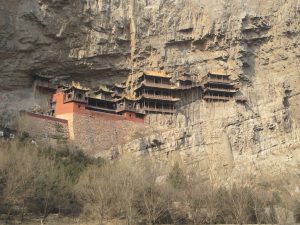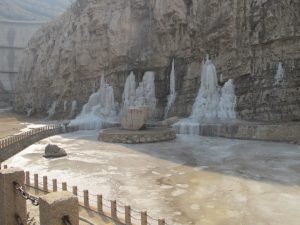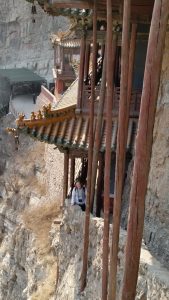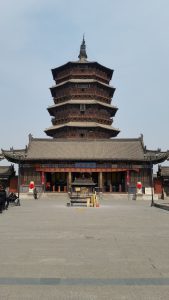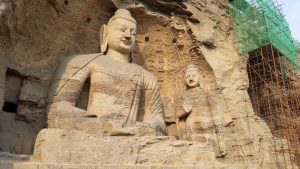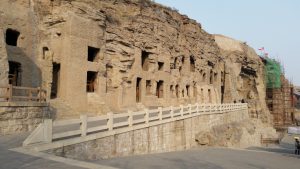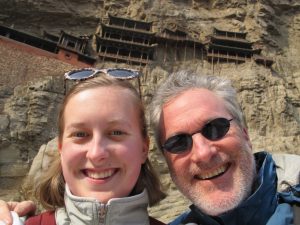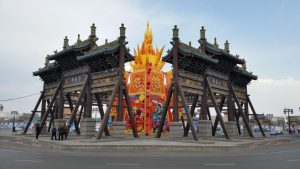 Like our day at Cangyan Shan, our sight-seeing around the northern Chinese city of Datong was very rewarding. We had our first night train from Shijiazhuang to Datong, arriving at 6:45 AM. The train was about as comfortable as a couchette in Europe, and Chinese trains run spot on to schedule. We were happy to find our room ready, even at 7:00 AM, in our lovely Datong hotel. Having made arrangements with our taxi driver to return for us, we indulged in a spectacular buffet breakfast and had rejuvenating hot showers before heading out for the area’s highlights.
Like our day at Cangyan Shan, our sight-seeing around the northern Chinese city of Datong was very rewarding. We had our first night train from Shijiazhuang to Datong, arriving at 6:45 AM. The train was about as comfortable as a couchette in Europe, and Chinese trains run spot on to schedule. We were happy to find our room ready, even at 7:00 AM, in our lovely Datong hotel. Having made arrangements with our taxi driver to return for us, we indulged in a spectacular buffet breakfast and had rejuvenating hot showers before heading out for the area’s highlights.
Our pleasant, though non-English speaking, driver sped us south to Heng Shan mountain, and the Hanging Monastery. WOW! No other word for it – wow! I don’t recall how I learned about this place but it is truly spectacular. Aptly named, this ancient Buddhist monastery defies gravity, clinging to a steep cliff, half supported by precarious-looking bamboo poles of varying lengths.
The valley itself is rather stunning, the narrow end blocked by a huge dam. The setting is made even more impressive by spectacular ice falls and a frozen stream below the monastery. In true Chinese style, very loud (but pleasing) music blares from visitor center loudspeakers. In this case, it added to the unique ambiance.
A long and steep climb was rewarded with panoramic views up and down the valley and the Indiana Jones-like exploration of the monastery itself. Low railings and the knowledge of what is missing under your feet made it a rather nerve wracking exploration. But what an experience! A definite highlight. We will have to include this in the next Imprint China tour.
After the HM, we made brief stop in the town of Yingxian to see the world’s oldest and tallest wooden pagoda. The Muta tower is over 200 feet high and impressive, though forlorn and weather beaten. But it was a perfect place for lunch and we had a pleasant encounter with engaging locals and a filling and inexpensive lunch.
Our final stop of the day was the most famous of Datong’s area sights – the Yungang Grottoes. These 5th-century caves have been carved by Buddhist monks, turning a cliff side into a collection of cave-temples. Numbering 252 caves, and boasting 51,000 statues, it is an impressive collection. 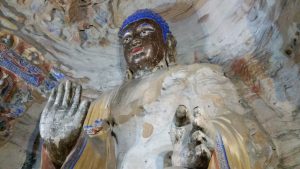 Many are closed for restoration, many more are weather-worn and damaged, but one cannot help but be impressed with the shear grandeur and scale of the place.
Many are closed for restoration, many more are weather-worn and damaged, but one cannot help but be impressed with the shear grandeur and scale of the place.
Like many “big ticket” sights in China, the entrance infrastructure nearly rivals the resource in terms of grandeur and panache. A huge new visitor center gives way to a massive decorated courtyard, huge statuary, elaborate entrance gates, lines of obelisks, bridges, and even a huge temple complex on stilts in the middle of a frozen artificial lake. Only after conquering all that does one arrive at the caves themselves.
 And the caves are still the star. Huge carved and sometimes brightly painted Buddhas, intricately carved internal pagodas, and Bodhisattvas beg for photos. Some of the best and most colorful ancient frescoes in China are within. Many walls are covered with dove-cote like niches, each containing a tiny stone or clay Buddha statue. Elegant depictions of angels, animals, and birds grace the walls.
And the caves are still the star. Huge carved and sometimes brightly painted Buddhas, intricately carved internal pagodas, and Bodhisattvas beg for photos. Some of the best and most colorful ancient frescoes in China are within. Many walls are covered with dove-cote like niches, each containing a tiny stone or clay Buddha statue. Elegant depictions of angels, animals, and birds grace the walls.
It was a fun scavenger hunt peaking in the many caverns to discover their hidden riches. After a couple hours of exploring and photographing, we braved the ubiquitous gauntlet of souvenir vendors to reach the exit. But not without tarrying just long enough to try some Chinese sweets. In this case the giant “bubble” waffles cones we’d been seeing quite often. The perfect sweet ending to a power-packed sightseeing day.

